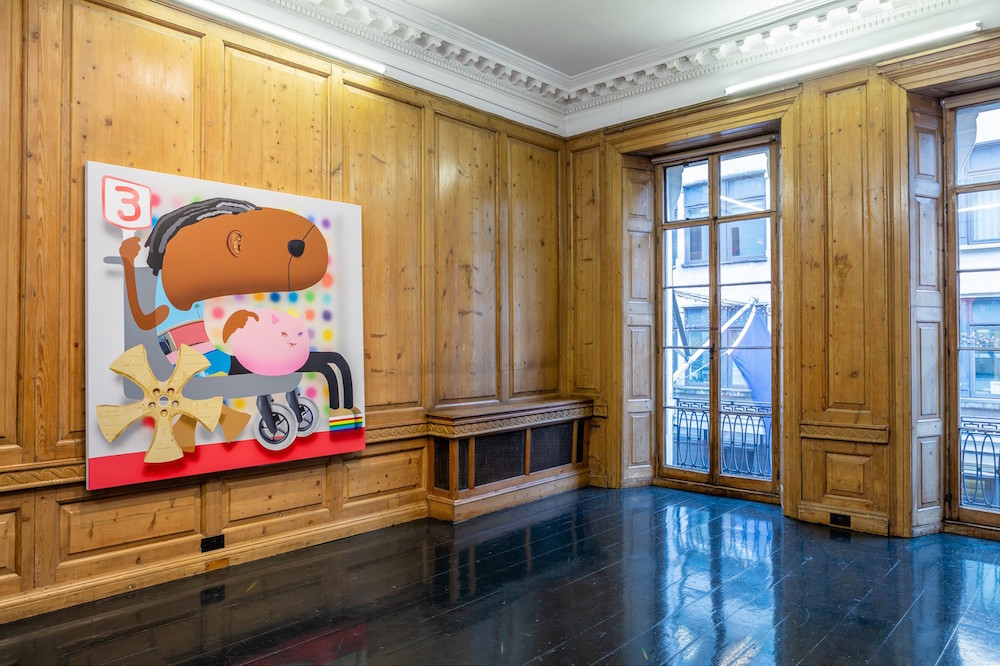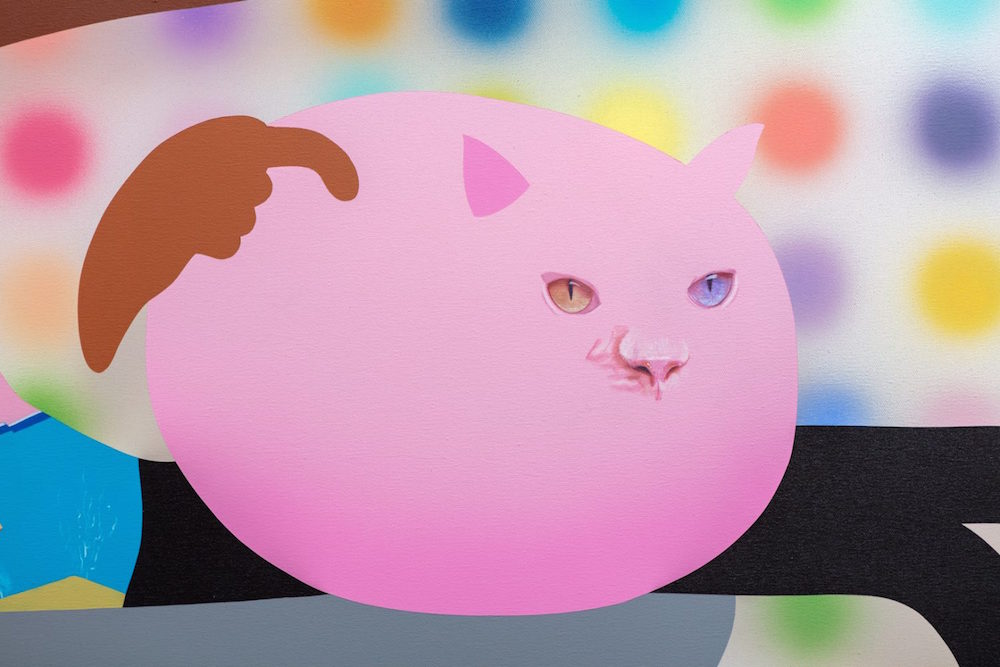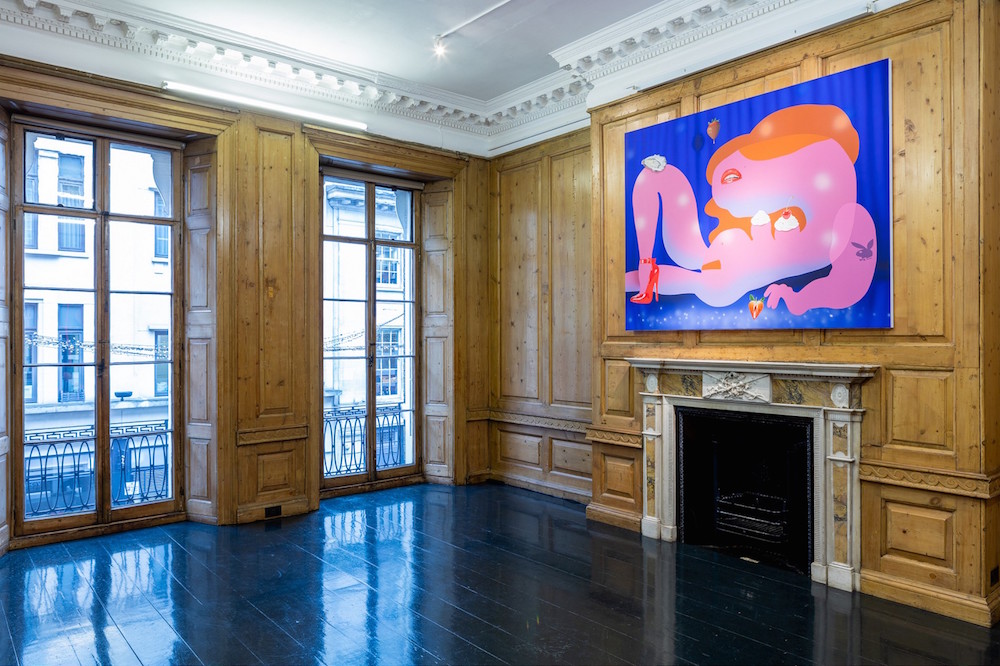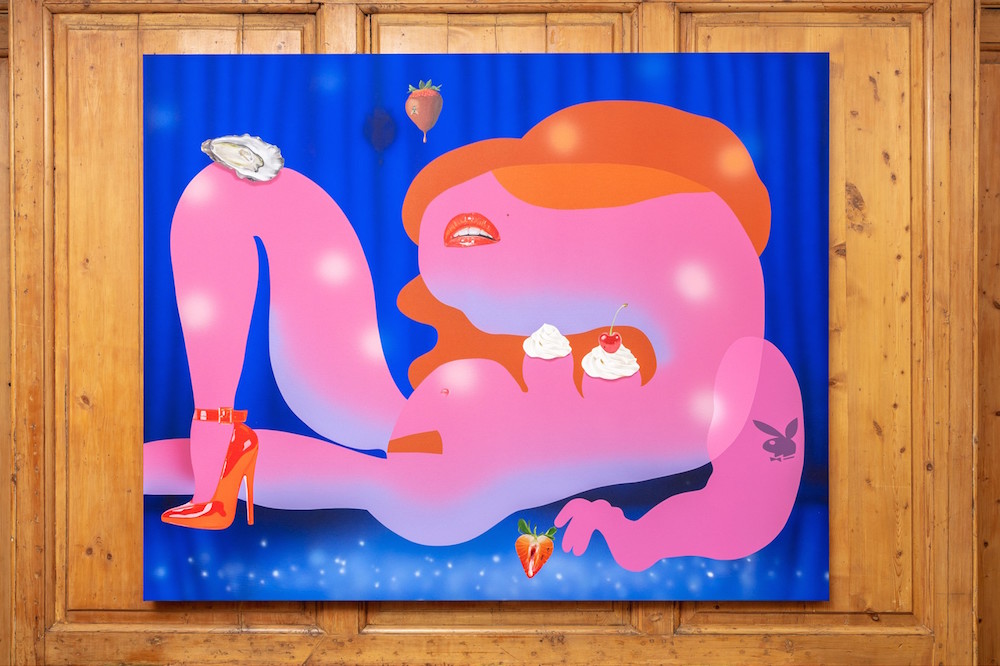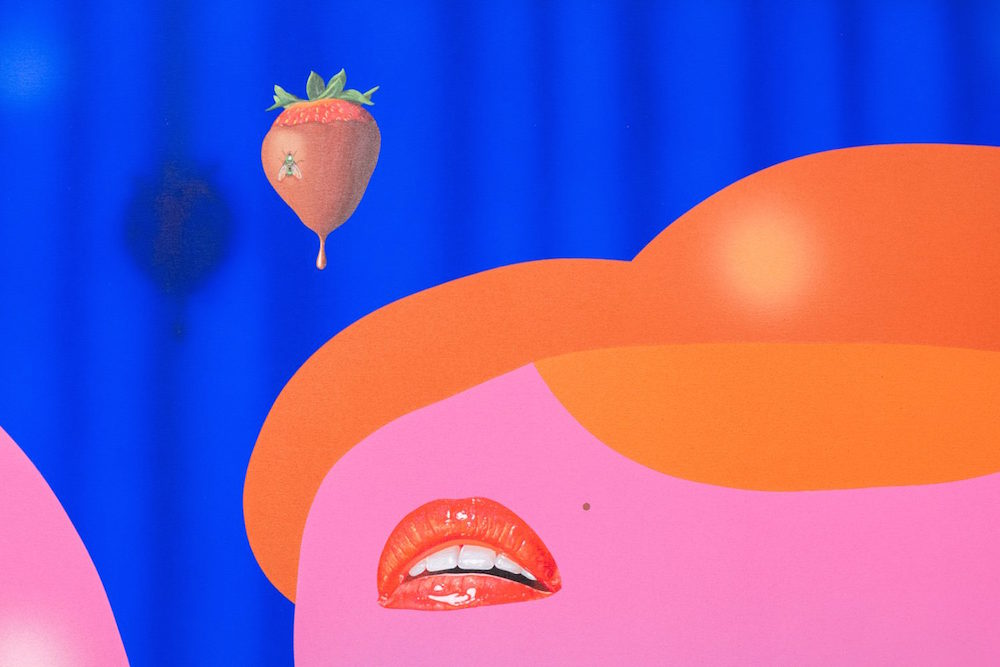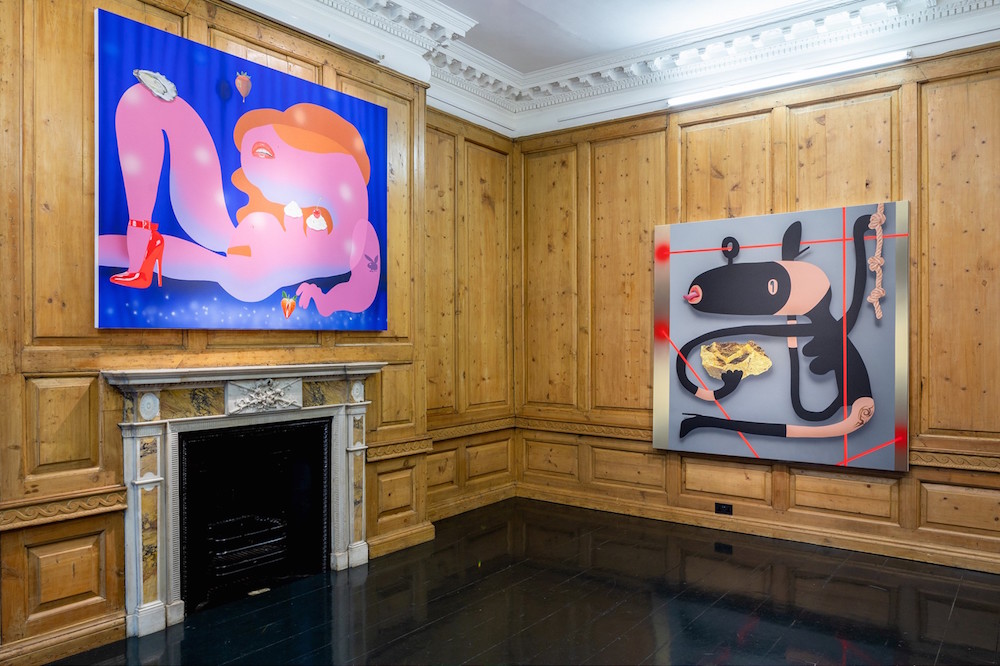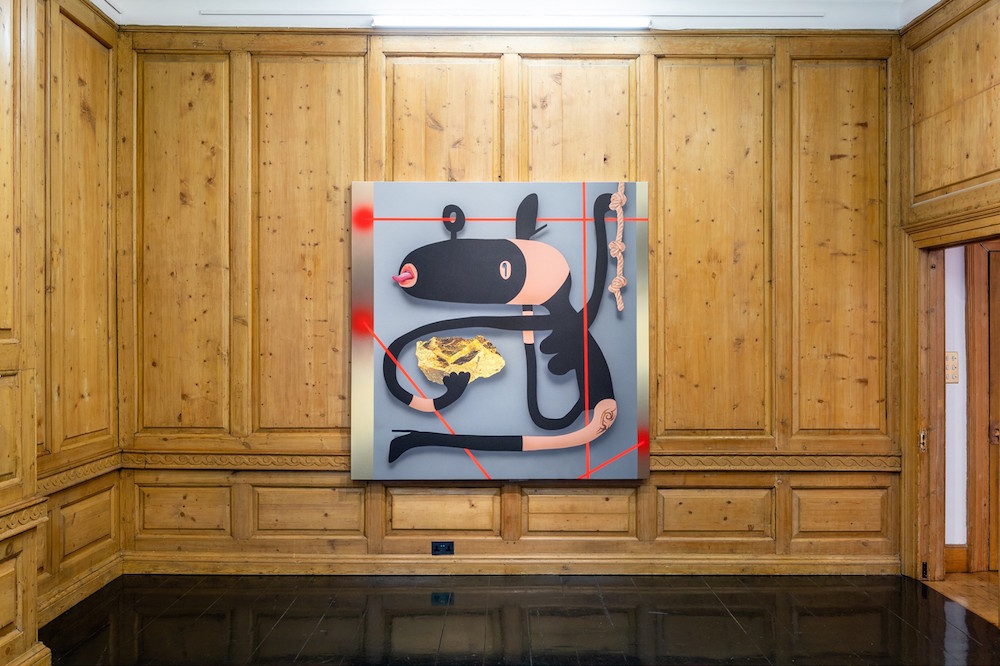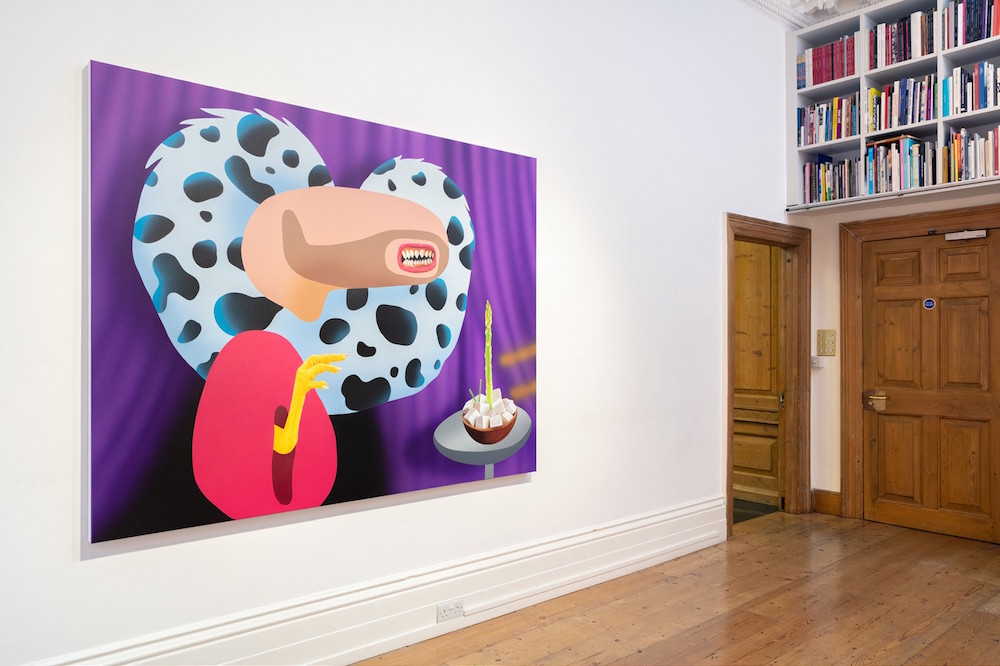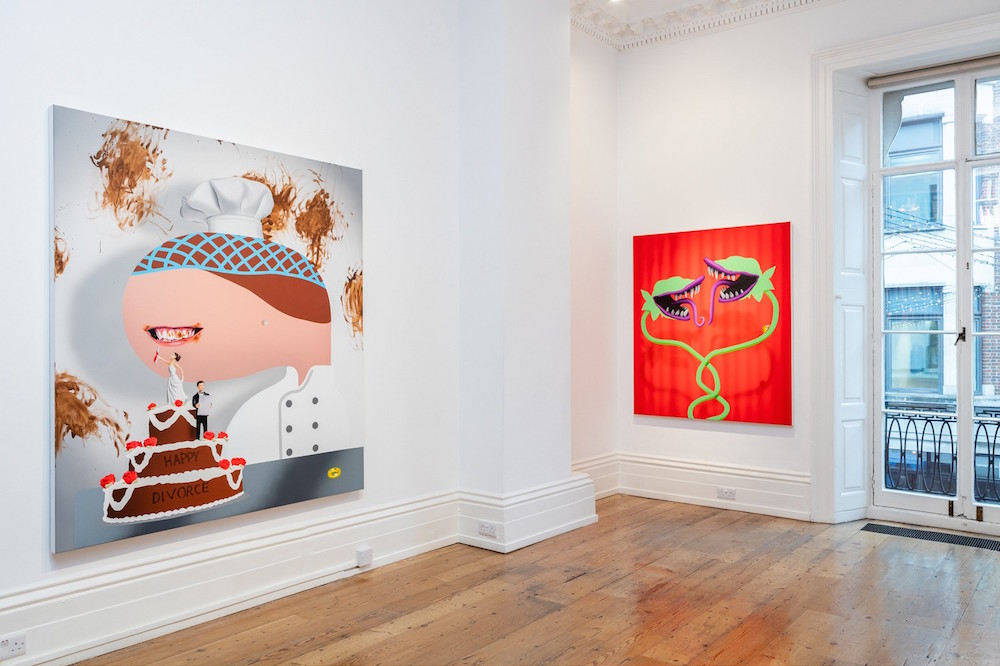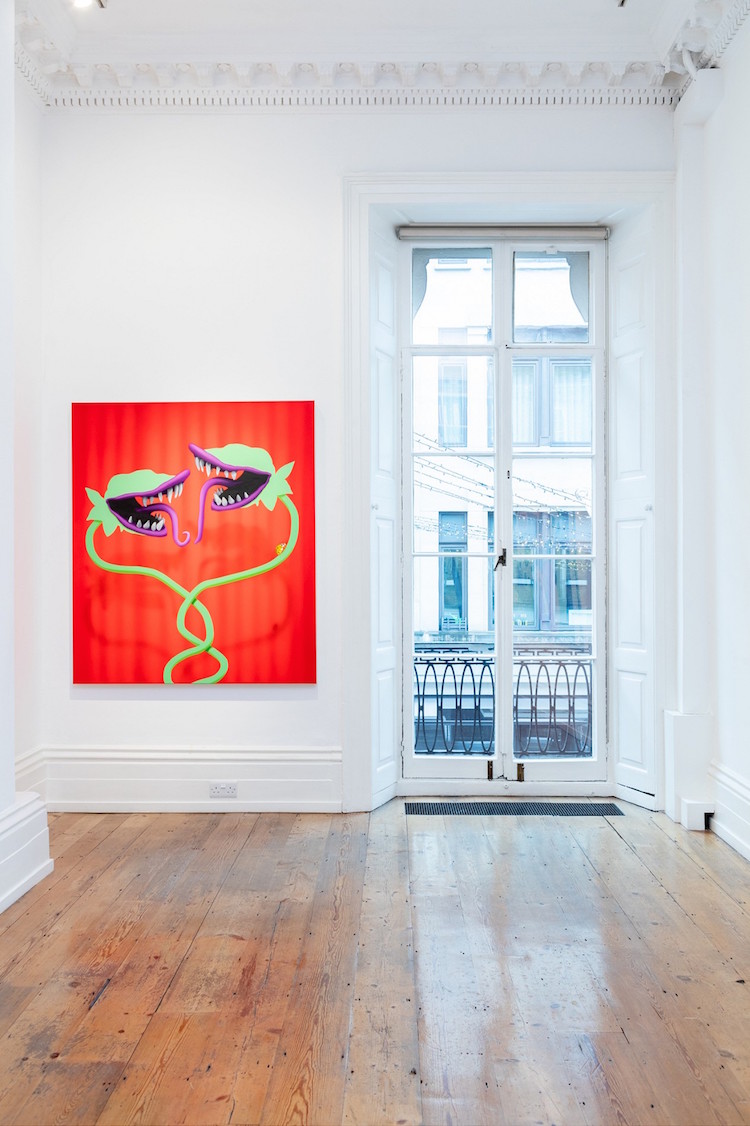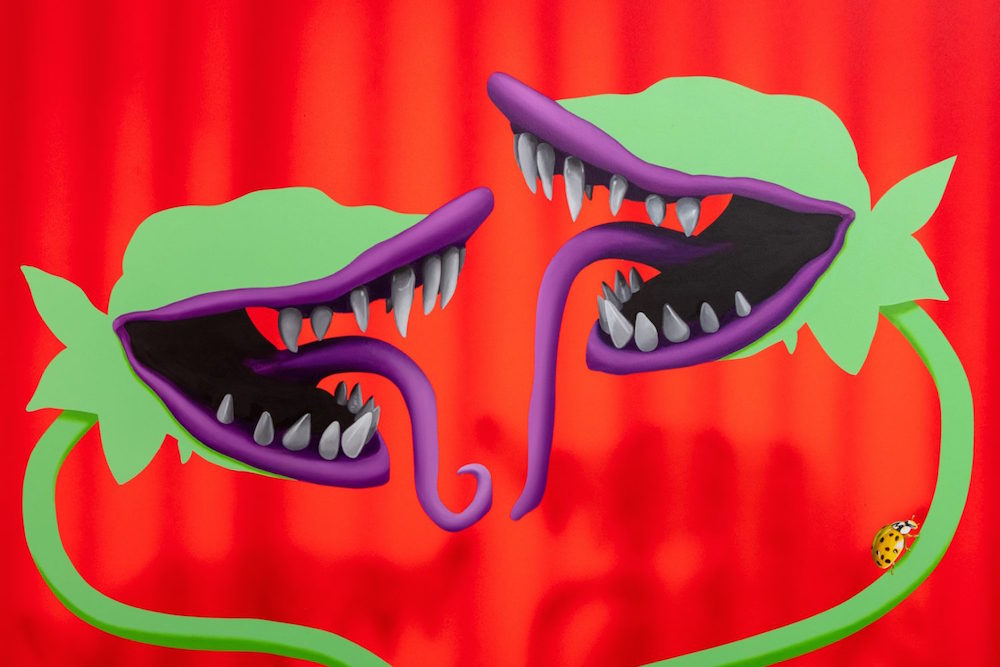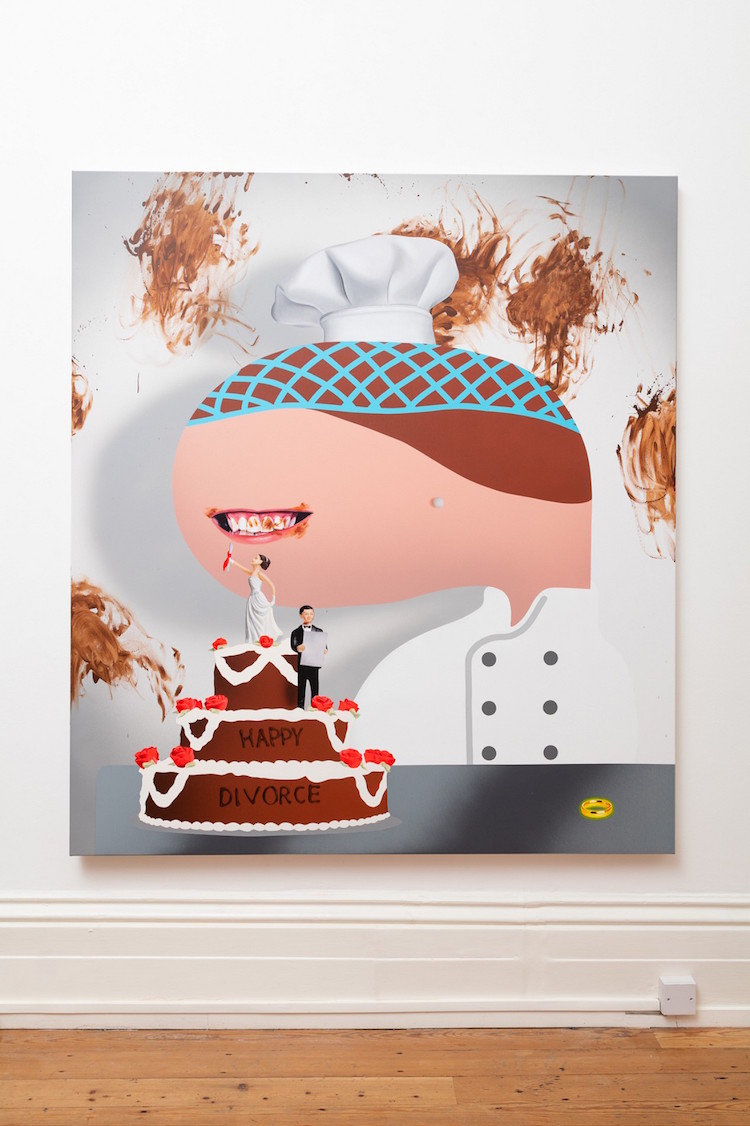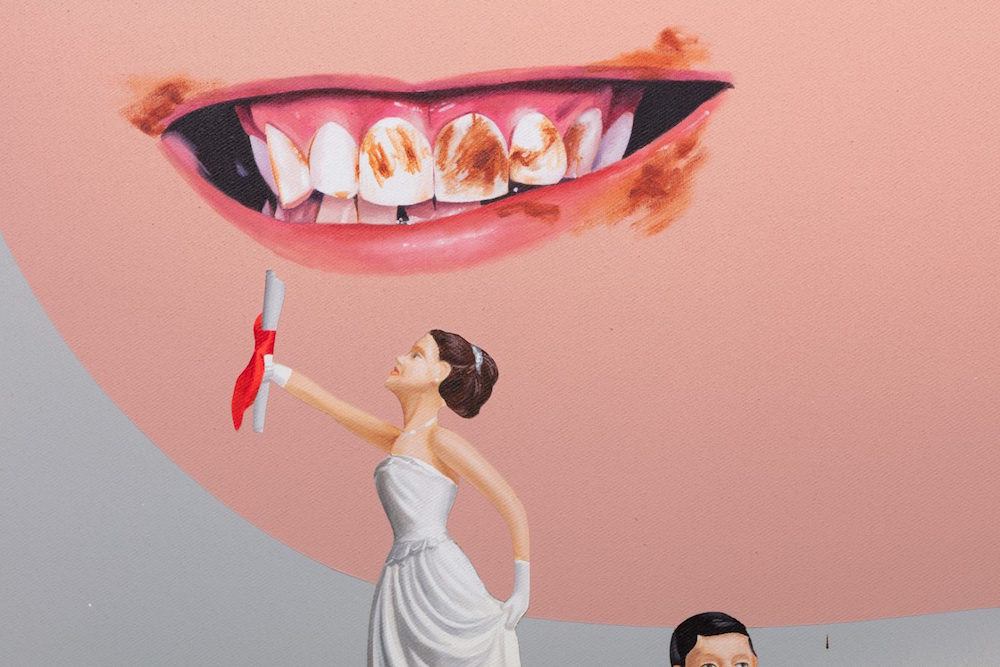Catching up on events missed during the holidays, we came across a favorite. Oli Epp's Oxymoron, a major solo presentation featuring a series of large-scale paintings, opened at London's Carl Kostyál on December 12, 2019. This latest work elaborates on the distinctive visual language and aesthetic he has spent years developing. Pushing both his concepts and technical skills even further, Oxymoron almost entirely focuses on capturing the beauty of a messed up world around us, a true Oxymoron in itself.
Contrasting the gallery's traditional wood-paneled walls, the unique humor of Epp's visuals burst with impact. Blind art collectors, curvaceous nudes in aphrodisiac, atmospherics, a thief pilfering a gold nugget or a distressed baker at work all portray exaggerated characters who address unlikely but plausible scenarios. Like Pedro Almodovar's movies, Epp presents fantasy and irreverence in quirky and conceivable characters and events.
Stripped of physical features but inhabiting graphic silhouettes, Epp's figures are defined in the food, accessories, and fashion items that swirl around them. Mixing the flawless plasticity of airbrush and the sharpness of masking technique with realistically rendered oil sections, Epp's visons become scarily real and alarming, despite haunting humor. Placed within a theater-like setting of blurred curtains draped in the background, each figure exaggerates real-life outrageousness, while commenting on lifestyles, trends or the emotional and social world in work that relates and connects with humor and impact. –Sasha Bogojev
Spring 2020 Fashion – Amanda Mounser
Untitled
Interview by Gwynned Vitello and Portrait by (?)
Whether black leggings and black turtleneck or flouncy, flowery bo-ho skirt and blouse, we pull on uniforms before stepping out to meet the day. But not before clasping that special necklace from a trip to Mexico or looking down at the opal ring that sparkles or simmers depending on the mood. Jewelry can send a message or just bestow private pleasure. It’s not chosen haphazardly, and it’s personal. Amanda Monsour makes little art treasures to enjoy whenever, wherever.
Gwynned Vitello: Big, rhinestone brooches bursting from bodices are my first jewelry memory. I saw them on glamorous actresses and on my Nonni who wore them at the Italian Family Club. Do you remember jewelry making a first impression?
Amanda Mounser: My mom really framed my first jewelry memories. She was, and is, so stylish and beautiful. She wore a ponytail with a bow and had the best chunky gold hoops and puffy shaped sterling earrings, bangles and cuffs. I remember wishing I would grow up to be as beautiful, sneaking into her jewelry box to admire that which helped paint that picture.
Jewelry is so associated with family roots. My Argentine mother-in-law practically expected that my daughter get her ears pierced on the way home from the hospital. Did you have a cultural tradition?
Umm, we were those children! I have two sisters, and we all had out ears pierced at 6 months. My English husband was so traumatized when he found out we had our them pierced so young. We also each had gold baby bangles and delicate mini-cross necklaces - so precious. We did have a lot of religious jewelry through the years, so I’ve always had a fondness for cross pendants and charms. My very first collection featured a layered necklace with 23 jeweled crosses. I also have my Mom’s St. Christopher’s necklace from junior high. He is the patron saint of travel, but she didn’t have it for religious significance - it was a token of love between two young lovers when their relationship became official. Which I love, and I actually still wear this pendant today.
You often reference sculpture. What were your first projects, and did you pursue art in school?
I knew from a young age I was going to have my own business in design, and I’ve always made things with my hands. In college I studied architecture, which included painting classes, though I switched to a business degree, thinking it might be more beneficial in the grand scheme of things. Through architectural studies, I fell in love with the idea of buildings and people like Le Corbusier, Mies Van de Rhoe, Frank Lloyd Wright, Bauhaus and Brutalism, the tension between form and function and the concept of residential dwelling that marries the indoors and out. It has influenced my design in the way I construct pieces. I reference a sculptural approach to design because I feel my pieces balance the positive space and the negative that is carved out and left behind. This is an important consideration in sculpture, so I think my pieces take on that nature organically because many components are sculpted from wax by hand. The composition of elements makes other pieces sculptural as they play with balance and proportion. I’m currently going back to my roots of drawing and painting - creating a series focused on the moon and the sun that dwell in the same nature-based world as my jewelry. I also have plans to develop art objects and larger scale sculpture to tell my story.
Tell us a little about Houston as an art hub. It’s always been a city that supported the arts, though I used to think of that in terms of oil-money supporting fine arts museums and opera. Now it’s also got a thriving urban art scene, What was it like for you growing up?
I actually spent my childhood in the town of New Braunfuels, 30 minutes outside of Austin in the hill country. The property where we grew up was dreamy - neverending trees and a house atop of a canyon with breathtaking views where we spent all day outdoors. Being immersed in nature planted those seeds of inspiration which have stayed with me. My experience with the Houston art scene was cultivated a bit later in my early 20s. Graduating from a conservative university that was more engineering than art theory. I remember being hungry for some kind of elevated inspiration source, and when I discovered the Menil Collection, Rothko Chapel, the Contemporary Arts Museum… saw a Matthe Barney film at the Museum of Fine Arts... stumbled on the Cullen Sculpture Garden (designed by Isamu Noguchi!) a serenity came over me, like a calming sense of the future.
What’s been the influence of the various cities you’ve lived?
Houston clearly provided a springboard for the world of art and architecture, but I always wanted to move to New York because it’s the center of everything, so I took the plunge pretty much in an instant. I moved there with a few hundred dollars, a duffel bag and the mindset that I was just going to make it happen. NYC taught me a lot of core life lessons - that I am more capable than I imagined, for one. It taught a new definition of hard work, and that taking risks and promoting yourself is the only path forward. I fell in love in New York! There is so much possibility there if you are truly open. I started my business with a tax return and the mindset to just see what happens. Low and behold, things started rolling, and I’m so thankful for all the support I had. Fast forward to Los Angeles. My husband and I traveled to the west coast several times and became enamoured. I’m obsessed with the natural beauty of the landscape, and because nature is such a big inspiration for me, couldn’t resist its intoxicating call. Careerwise, I see LA as a place of new, creative awakening.
Is there a locale that would be a dream “residency” ?
I’d love to spend an extended period of time in Asia – Japan, Bali, Indonesia, Thailand, and Hong Kong. Just exploring that’s somewhere very different for me. Never say never, but I’m pretty sure we’ll remain in LA, we just love it!
Making jewelry seems like a very singular creative endeavor. You’re not draping fabric on models or factoring size or season.
One thing I love about jewelry design is that you don’t have to rely on a lot of other factors that could create delays in the design and development process. I can make changes quickly and pivot pretty seamlessly within the development stage because it’s one size fits all.
Tell me about your materials and process.
My line is costume jewelry, and everything is base metal, brass or sterling silver with rhodium or 14k gold plating. I love working in metal because of the unusual shapes I can create.I am also super into materials that capture light. I like to use Swarovski faceted gems and cubic zirconia pave elements in organic shapes like a wave or teardrop. I frequently use baroque and freshwater pearls of varying color tones, as they naturally carry a sculptural shape. No two pearls are the same, which makes each piece I one of a kind. I marry delicate elements like thin, almost invisible rings with more substantial ones like thick, chunky balls because the way they balance and float between one another is very interesting.
What I love most right now is the process of sculpting shapes from wax to create models for casting. The process is really active and therapeutic, and I’ve always loved working with my hands. I feel like there is this sense of creation to the end product. Wax can be very fragile, especially when you get to an area where walls are thinner; but through the process you learn patience, finesse and the boundaries of manipulation. I use a lot of baroque and freshwater pearls - they hold a naturally sculptural nature, and I love that no two pieces are alike.
How do you use color in your work? Are your creations meant to enhance color around us?
I try to create abstract mementos that manifest the essence of the natural world, so the perfect shade of green to replicate the sea or rosy tone of a sunset. The color I use is meant to jog the feeling of a facet of nature. I love the way color can lay with light, so I also try to utilize it in a light catching context.
What visual artists have influenced your work? Actually, there’s no reason to limit the influence to painting or sculpting. Musicians, architects?
Some, but not limited to, are Cy Twombley, Dan Flavin, Helen Frankenthaler, Isamu Noguchi, James Turrell, Jean Arp, Le Corbusier, Matthew Barney, Steven Parrino, Sophie Taeuber-Arp, Wolfgang Tillmans and Yves Klein. I listen to Air, Radiohead, Aphex Twin, Orbital, Kraftwerk, and Massive Attack. The sound composition of those artists gets me in a solid creative flow.
Asymmetry comes up in conversations about your work. People often have trouble with that, whether clothing or jewelry. Why do you think it almost stresses some of us, while you embrace it?
I know what you’re saying because, while I appreciate an even flow, for me, imperfection is the beauty. It adds a point of interest, a question mark, it makes you think and consider the piece as opposed to being something that’s more straightforward and assumed right away. It becomes kind of transcendent in its irregularity.
We choose clothing for utility or to project an image or allegiance. Diamond tiaras notwithstanding, I think that jewelry is a far more personal choice. Almost like perfume, it seems that someone picks jewelry because they really feel a connection to a piece. Do you agree?
Yes, and for me, I hope people connect to a piece of Mounser jewelry specifically as they would a piece of artwork. I want it to draw them in with an indescribable magnetism. I want the piece to possess a sense of allure that calls to them in a joyous way. I think this gives jewelry a deeper meaning beyond just sentiment. It’s the opportunity to incorporate something unique into the fabric of special pieces that make up one’s personal sense of style.
@mounserstudio
mounser.com

